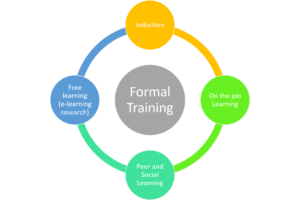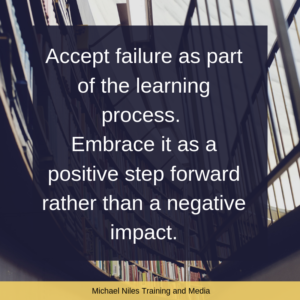Now I don’t want to do myself or other trainers out of a job, far from it, but you’ve attended that expensive external training course, now what?
Training is the Bedrock of a Learning and Development Process
Training is an essential part of the health and development of a business. Train your staff well and they are skilled, engaged and productive. You create subject matter experts your clients can trust and staff who are motivated. Surely a win-win situation.
Formal training, whether in house or external, forms a solid platform to create excellence. But only if it goes somewhere. Too often courses are offered that have no context to the role or attendees are not given the opportunity to develop the idea in the workplace.
A training Course has to have Context.
In my last role, I attended 2 training courses that fit this profile. Firstly, we were invited to attend an advanced Excel session. I love Excel and leapt at the chance to go. I had a nice half day in a training room, learned some new stuff, remembered some old stuff, brilliant course well delivered. Now what?
Nothing, I did not use Excel in my role, I had no need to learn more and had no opportunity to apply it. Which was probably the case for 50% of the people who attended. So, what was the overall benefit of that training to the company? Actually, a loss of productivity for those who had a bit of a jolly and learned nothing useful for their role. I’ll talk about the second later.
On the Job, Peer and Formal Training.
This is often referred to as 70 – 20 – 10 learning, based on research done in the 1980s by Morgan McCall at the Centre for Creative Leadership. It posited that 70% of learning is on the job, 20% peer learning and 10% formal training. Over the last 30 years, this has evolved somewhat. You can listen to this podcast from Tom Whelan (Director of Corporate Learning, TrainingIndustry.com) for a more up to date version.
So effective learning and development requires a culture that encourages learning inside and out. It has to be focused on adding value to the individual job role and ensure that on the job, social and formal training are strategized, given time and consistently encouraged.
Change the Culture, Give Permission to Learn.
To create the best learning and development environment, permission to learn has to be embedded from induction and consistently developed throughout the staff members journey. It also has to be a company-wide strategy with senior management as engaged and involved as the staff.

Skills, like coaching and mentoring, have to be trained at all levels. The ability to give and receive constructive feedback is imperative to fully optimise peer learning opportunities. Formal training, whether delivered in house or externally, is required to create a solid platform to build this self-fulfilling system.
Where to start
Here are some starting points to build a strategy.
- Induction. Install this from the very beginning, create an induction programme that embeds a learning culture.
- Identify Influencers. Look at your existing staff and identify those with expertise, experience and skill. Then train them how to share those skills with others.
- Share Learning. If someone attends a formal training course make feeding back to peers part of the expectation.
- Identify Relevant Opportunities. Make learning specific to the role, ask yourself how it can be practically applied on the job and what value will it add, before investing time or money.
- Create a space for people to share. Whether it’s an online solution like Yammer, regular feedback or a focus group. Make sure time is allowed for all types of sharing.
- Add Value, Be Relevant: The best way for learning and development to benefit your business is for it to add value to increase skills, engagement, motivation and productivity. For it to benefit your staff, they have to see how it helps them grow, add value and interact positively with colleagues and clients.
- Give permission to Fail. Failure is an essential part of learning, particularly if the skill or role is new. Accept failure as part of the learning process and embrace it as a positive step forward rather than a negative impact.

This is no quick fix
Implementing this into an existing business is difficult. Some will get it straight away, some will need convincing and others will resist it tooth and nail. There will be difficult times and failures along the way (but we’re allowed to fail now aren’t we). This is an ongoing, drive towards excellence. It requires commitment, energy, planning and sacrifice. However, the end result will be a holistic, blended learning experience that positively effects staff, customers and the business.
Change Management but no Change to Manage
Here is my second example of poorly implemented learning. 5 staff members, including myself, were given the opportunity to attend a 2-day Effective Change Management course in London. I am from a management background and it was an excellent refresher for something I’d not used for 10 years. The crux was that, with 1 exception, none of us had a change that needed to be managed. We had no business context, no reason for the learning and would not have the opportunity to implement it in the workplace. Where was the value to me, the business or the client?
Now I am working for myself that training is really helpful, and I am implementing that learning on a daily basis, for myself and for clients. But for its original purpose, it was an expensive couple of days out and generated no inward investment for the company.
So What Next?
The next time you look at popping yourself or a staff member on a course ask yourself what next? Where can this lead, how does it impact the business, how will that impact be communicated throughout the company and help the business grow?
This can be very challenging for small businesses, so if you are looking for some assistance please do get in touch. My practical management background, as well as my experience in training and coaching, will help to identify a clear learning and development structure for your business. Where necessary I can also continue to support you throughout its implementation and beyond.